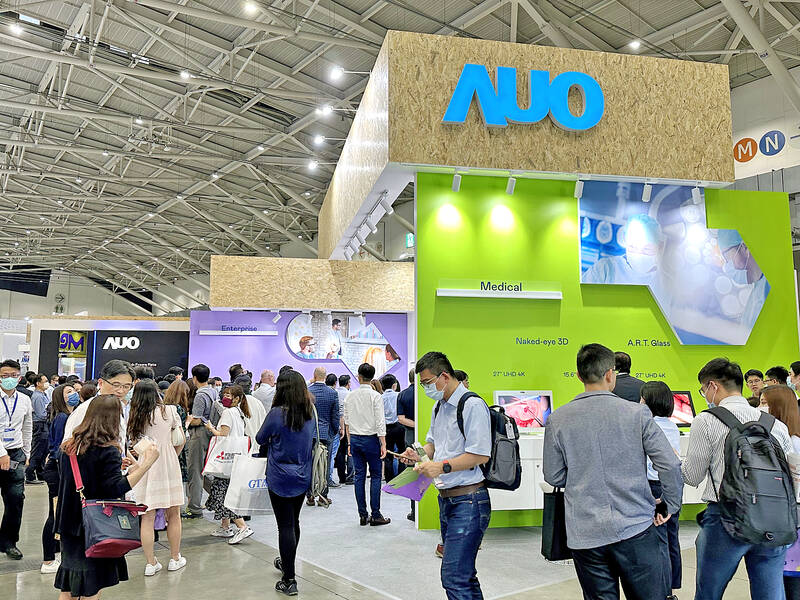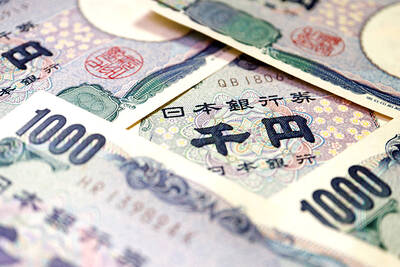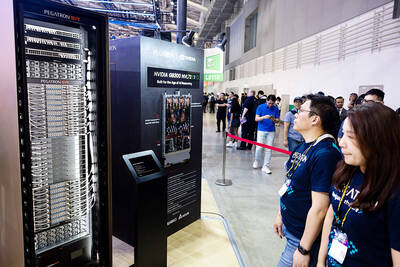Flat-panel maker AUO Corp (友達) yesterday posted its smallest quarterly loss in about five quarters as customers restocked ahead of shopping seasons, and demand for TVs and notebook computers emerged from two years of corrections.
AUO’s net losses improved to NT$975 million (US$30.07 million) in the quarter ended Sept. 30, compared with losses of NT$10.91 billion in the second quarter and NT$10.43 billion in the third quarter last year.
Gross margin rose to 7.6 percent last quarter from 3.1 percent the previous quarter and minus-14.6 percent in the same period last year.

Photo: Chen Mei-ying, Taipei Times
Shipments climbed 3 percent sequentially last quarter, driven by seasonal demand, the company said.
Average selling prices jumped 5 percent quarter-on-quarter to US$329 per square meter, the first uptick since the first quarter.
This quarter, shipments of computer and TV panels would dip about 15 percent sequentially as restocking demand among customers is approaching an end, AUO said.
The upward trend of average selling prices would extend into this quarter with a quarterly increase of 2 to 3 percent, the company said.
“The seasonal restocking demand is to phase out in the second half of the fourth quarter,” AUO chairman Paul Peng (彭?浪) told investors during a quarterly meeting yesterday. “Consumer demand for end devices is expected to remain weak for a period of time because of lingering macroeconomic pressure. Key interest rates in the US are still very high.”
The bright spot is that demand and supply dynamics in the flat-panel industry are moving in a positive direction, with channel inventory returning to healthy levels, while TV and PC brand vendors are taking a prudent approach to manage inventory, Peng said.
Most panel manufacturers have adjusted their equipment utilization to match demand, he said.
AUO said its factory utilization was 80 percent last quarter, but it planned to lower it this quarter as demand declines.
The company yesterday trimmed its capital spending plan for this year by about 14 percent to NT$30 billion, compared with an estimate of NT$35 billion three months ago.
AUO said it would only spend on next-generation display technology, not on expanding capacity.
With years of investment, its micro-LED technology would be commercialized by the end of this year, with shipments to start for use in smart watches, it said.
The next applications for the new display technology would be premium TVs and vehicles, AUO said.
To facilitate the production of micro-LED panels, AUO’s board of directors yesterday approved an investment of NT$700 million to build a 6-inch micro-LED chip-on-carrier production line in Taoyuan’s Longtan District (龍潭) with subsidiary PlayNitride Inc (錼創).
AUO yesterday provided additional details about its ambition to become a major supplier of intelligent cockpit operation systems by acquiring Germany’s Behr-Hella Thermocontrol GmbH.
AUO supplies flat panels used in vehicles, as well as modules integrated with touch and human-machine-interface (HMI) features.
It said it expects revenue from displays with HMI features to make up about 25 percent of its revenue from automotive displays in 2025, up from 10 percent this year, driven by the uptake of electric and autonomous vehicles.

AI TALENT: No financial details were released about the deal, in which top Groq executives, including its CEO, would join Nvidia to help advance the technology Nvidia Corp has agreed to a licensing deal with artificial intelligence (AI) start-up Groq, furthering its investments in companies connected to the AI boom and gaining the right to add a new type of technology to its products. The world’s largest publicly traded company has paid for the right to use Groq’s technology and is to integrate its chip design into future products. Some of the start-up’s executives are leaving to join Nvidia to help with that effort, the companies said. Groq would continue as an independent company with a new chief executive, it said on Wednesday in a post on its Web

RESPONSE: The Japanese Ministry of Finance might have to intervene in the currency markets should the yen keep weakening toward the 160 level against the US dollar Japan’s chief currency official yesterday sent a warning on recent foreign exchange moves, after the yen weakened against the US dollar following Friday last week’s Bank of Japan (BOJ) decision. “We’re seeing one-directional, sudden moves especially after last week’s monetary policy meeting, so I’m deeply concerned,” Japanese Vice Finance Minister for International Affairs Atsushi Mimura told reporters. “We’d like to take appropriate responses against excessive moves.” The central bank on Friday raised its benchmark interest rate to the highest in 30 years, but Bank of Japan Governor Kazuo Ueda chose to keep his options open rather than bolster the yen,

Even as the US is embarked on a bitter rivalry with China over the deployment of artificial intelligence (AI), Chinese technology is quietly making inroads into the US market. Despite considerable geopolitical tensions, Chinese open-source AI models are winning over a growing number of programmers and companies in the US. These are different from the closed generative AI models that have become household names — ChatGPT-maker OpenAI or Google’s Gemini — whose inner workings are fiercely protected. In contrast, “open” models offered by many Chinese rivals, from Alibaba (阿里巴巴) to DeepSeek (深度求索), allow programmers to customize parts of the software to suit their

Global server shipments are expected to surge to 15 million units next year, from 4 million units this year, with artificial intelligence (AI) servers accounting for about 30 percent, driven by massive capital spending by major cloud service providers, the Market Intelligence and Consulting Institute (MIC) said on Thursday last week. Major cloud service providers — including Google’s parent company Alphabet Inc, Microsoft Corp, Amazon.com Inc and Meta Platforms Inc — are projected to budget US$450 million for capital expenditure next year, up from US$400 million this year, MIC ICT [information and communications technology] Industry Research Center director Edward Lin